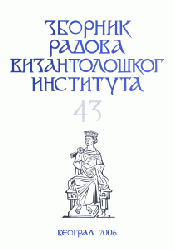Pseudo-Sfrancis o srpskim zemljama
Pseudo-Sphrantzes on the Serbian Lands
Author(s): Maja NikolićSubject(s): History
Published by: Vizantološki institut SANU
Keywords: Pseudo-Sphrantzes; Chronicon Minus;
Summary/Abstract: The Memoirs of George Sphrantzes are preserved in two versions. One of them is the authentic text by Sphrantzes, Chronicon Minus, a memoir of a pronounced chronographic nature, describing the events between 1413 and 1477, which the author recorded as an active participant and a contemporary. The other version is Chronicon Maius, also called Pseudo-Sphrantzes, a compilation composed between 1573 and 1575 by a famous forger, the Metropolitan of Monembasia Macarius Melissenus. Being a collage from different sources, his work contains some data on the Serbian lands which exceed the chronological limits of Chronicon Minus, i.e. of the data given by Sphrantzes himself. The structure of this chronicle — parallel stories on Byzantine emperors and Turkish rulers — resembles the so-called Venetian-Byzantine short chronicle Nr. SOB, written between 1474 and 1574. Chronicon Maius gives the year 6865 (=1356/7) as the year of the conquest of Gallipoli by Murat I. The same date is given in five out of seven manuscripts of the short chronicle Nr. 53. Finally, Ecthesis Chronica, a work by an anonymous author of the 16th century, is, apart from Macarius Melissenus, the only source written in greek that explicitly mentions the name of the daughter of the Despot Djuradj Brankovic, Mara, who was sent to the harem of the Sultan Murat II in 1435. Many of the reports on the Serbian lands given by Melissenus are in actual fact short and imprecise paraphrases of the data given by Laonicus Chalcocondyles in his historical work. In the first place, this holds true for the reports on the meeting in Serres, the reign of Beyazid I, the civil war among Beyazid's sons and the reign of Murat II. Finally, Chronicon Maius partly overlaps with the data from Chronicle of the Turkish Sultans, an anonymous work composed in the first quarter of the 17th century. E. A. Zachariadou has proven the dependence of this source from the text of the second edition of Francesco Sansovino's Gl' Annali Turcheschi, published in Venice in 1573. These three sources, Pseudo-Sphrantzes, Chronicle of the Turkish Sultans and Annals of Francesco Sansovino, are clearly interdependent. Chronicle of the Turkish Sultans doubtlessly draws from Sansovino's annals, whereas the precise relationship between Pseudo-Sphrantzes and Sansovino is still to be explored.
Journal: Зборник радова Византолошког института
- Issue Year: 2006
- Issue No: 43
- Page Range: 127-141
- Page Count: 13
- Language: Serbian

